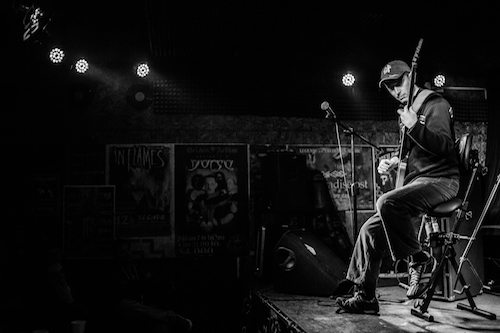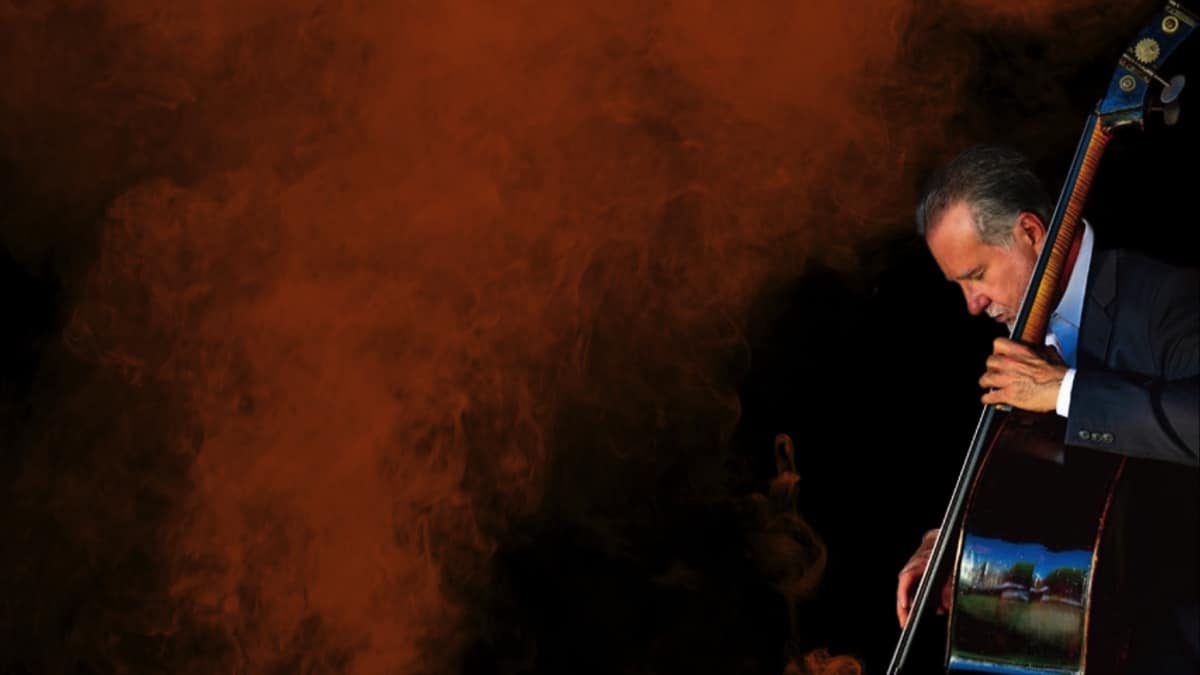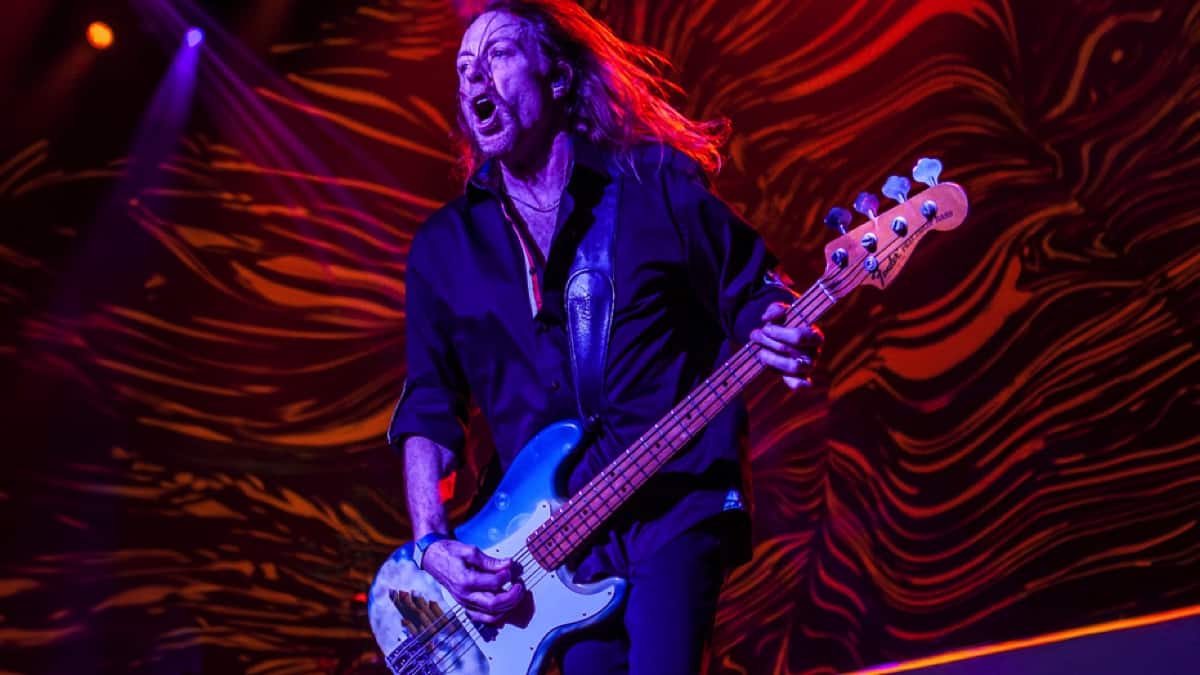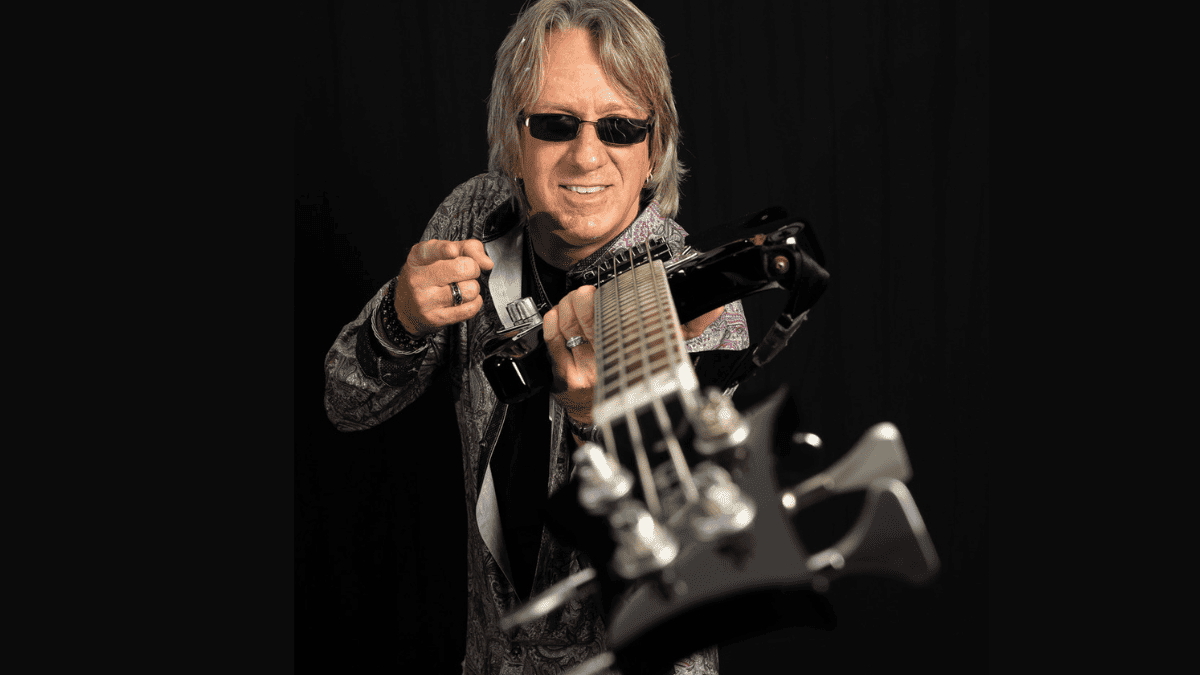Cover
ERB Legend Igor Saavedra – Bass Musician Magazine, December 2016 Issue


ERB Legend Igor Saavedra
Igor is what we can call a Renaissance Man; he has been a driving force on the ERB field for almost two decades. He is considered the father of the 8-String Bass, the inventor of the MicRamp, gifted with an outstanding technique, which he calls VST, and is a bass soloist in his own right. Igor is a fine Fusion and Jazz player and an authentic ambassador of South American music and culture. Here’s what he has to share with us…
Please tell us about your musical background and that crucial moment when you decided to move into the ERB field.
My story is very uncommon, in the sense that I started in music back in 1988 when I was 22 years old. Back then I didn’t even know what a Bass was, what Jazz was, etc., in fact music was as important in my life as playing with my Rubik cube.
I am a 100% self-taught musician. Despite that, in 1989 I was playing professionally with most of the top artists in my country. By 1990 I was already playing a 5-string Bass and in 1991 I got a 6-string, which I played until 1999 when I decided to go for “the big move”.
I had been considering building an 8-String Bass for many years, mostly due to my personal ergonomic needs; I have very small hands and I was looking for a solution that would allow me to reach those notes I wasn’t able to. Another reason that was pushing me into the ERB field was that I’ve always preferred the sound texture that a bass can offer between the 1st and the 12th fret, so in order to stay mostly in that area I definitely needed more strings. The third reason was that my right hand technique (VST) works much better when it has more vertical structures available and an ERB provides exactly that.
There were already 5, 6, 7 and 9 string ERBs around, but there were no 8-String ERB options, so there was also a natural push to be the first to dedicate a life as an instrumentalist to that specific Bass which I felt it was literally waiting for me. I say, “First to dedicate…” because it’s statistically possible that there could have been an 8-String Bass before mine, but I believe, ‘the father’ is the one who goes along the path raising his child on an everyday basis. So yes, there is a chance that there might be an 8-String Bass “progenitor” somewhere, but that wouldn’t change anything since for me, the 8-String ERB is exactly like a son that I’ve been raising for almost 20 years.
What would you say to all those ERB haters around?
An ERB hater is just “a hater”; the ERB part of the phrase is completely unimportant to me.
I have a very clear life philosophy in relation to these matters. The way I see things, I can’t go against anybody or anything, so if I don’t like something I focus on favoring its opposite. I also don’t allow myself to get angry, since I am the only one responsible for everything that happens in my life, which includes my reaction to things and situations around me. This way of thinking has allowed me to stay happy and plentiful on a daily basis in the short and uncertain period of existence that nature kindly offered to us. There’s of course a very deep theoretical support for all this, but it is obviously not the place for getting deep into those matters.
That being said, my position towards the concept of “Hate” appears quite obvious. I see hate as the exacerbation of “being angry,” just before the concept of resentment which is IMHO the worst of all because it defies the opportunity that times gives to it, so to vanish and fade away.
Bottom line, you can now easily extract from my words that I obviously consider any hater as an unhappy, irresponsible and sad human being. An “ERB hater,” a subject that canalizes some of his/her inner hate towards that specific context, because definitely as it always happens with this kind of individuals, ERBs will be just one more depositary of the many hates in their lives.
In your opinion, what are the benefits and downsides of playing with an ERB?
Downsides are very few…
The muting aspect demands a lot of working/cleaning time until you see effective results
The instrument is generally bigger and heavier.
Finally, as the radical instrument they are, ERBs will always attract haters around them and that’s something that you have to really learn to deal with, but once you do, that specific problem vanishes in the dust.
The benefits are many… for example an ERB is an “elastic” instrument that can allow you to easily solve that size/weight downside I just mentioned. For example Octavius (my 8-String Bass) weights just 8.6 lbs. (3,9 Kg.) and has a 33” scale and a 15.5 mm string separation at the bridge, enough for playing slap and for having a neck width just a little bit wider than a 6-string bass with 18 mm string separation. Also when the strings are closer to each other, moving across the strings becomes instantly easier and the technical reasons for that are very objective.
Another big benefit is that once you have more strings you instantly have tons of chord voicing and scale fingering options, all of them available in a vertical disposition, which will be way more comfortable and finger friendly; quite the opposite to what people could imagine.
Finally, as I mentioned on my answer to the first question of this interview, I much prefer the sound of any bass when it’s played between the 1st and the 12th fret.
How do you take care of the string-muting and string-spacing issues?
In relation to string-muting, after having tried so many techniques and finger combinations, I realized that it was really so easy and simple that I almost had nothing to do at all. I call it “passive muting” and it’s quite simple.
It’s important to say that when I say “below” or “over” I’ll be referring to the physical position and not to the frequency. When I say “higher” or “lower” I’ll be referring to the frequency and not to the physical position.
I mute all the strings, which are “below” the “higher” string I’m playing by simply and gently extending the phalanges of either the 1st, 2nd, 3rd and 4th finger of my left hand and resting any of them or all of them softly on the thinner strings. On the other side, I mute all the strings which are “over” the “lowest” string I’m playing by simply resting the external section of the thenar eminence, that fat palm muscle that flexes the thumb, of my right hand gently on the thicker strings.
In relation to the string spacing, as I said I’ve been using 15.5 mm of string separation on the bridge for the last 20 years and I just love it since it allows me to play comfortably and it doesn’t affect my slapping. At the same time I use a very radical narrowing angle of the fingerboard/neck towards the nut, so as a result of that the nut width of my 8-String bass is just 65mm wide. This is because I simply don’t need any more space between the strings for my left hand; the closer to each other the strings are (mostly in the first 5 frets) the better for me, the string proximity limit only matters for the right hand, and that limit is determined by the string separation at the bridge since if you set that measure too small you simply won’t be able to play slap.
Please tell us how your extended range bass has evolved through the years.
The 8-String Bass was surrounding my mind from the early stages of my career, but since these were not in stock in those days (and still aren’t) I had no knowledge to even order such a bass from a Luthier. Instead, I just went for a 6-String bass first, which was the only bass I used for many years.
The decision to finally make an actual 8-String ERB came at the beginning of 1999. I showed my drawings to the excellent Chilean Luthier Alfonso Iturra, who fully sponsored me and proficiently made my first 8-String ERB in a matter of months. That was the very first “Octavius,” which now I call “Octavius 1.0.”
In 2006 we finished our sponsor agreement and I contacted another great Chilean Luthier, Claudio González, who made Octavius 2.0. This was a much better bass than the previous one, not because one Luthier was better than the other, but mostly because I learned a lot in those last 7 years with Octavius 1.0.
Between 2013 and 2015 I was briefly sponsored by the Spanish Luthier Oscar Prat, who made Octavius 3.0 (prototype and final version). This bass was really radical because for many years I had an idea of making my basses with detachable wings and headstock so I could easily travel with them on any airplane cabin, but without sacrificing at all the quality of its sound. The results were impressive and because of that I could confirm that this was going to be the way I would go in the future.
From the beginning of 2016 I started to endorse RMI basses from England. Mark Ramsay, who’s the president of RMI, has been incredibly supportive with me. Unfortunately we were not ready before the publishing of this ERB special so you could see the images, but the good news is that we’re just 2 months away from being able to show the best version of Octavius ever made, Octavius 4.0 by RMI (also detachable).
On this bass I did my best effort so it could reflect all the new things I’ve learned over the years and at the same time all the expertise Mark Ramsay has in the field.
Tell us about the evolution your ERB playing technique has experienced through the years.
In the early days when I was playing 4 and 5 string basses I just played with the pizzicato conventional technique, but around May 1990 I started to feel a little pain on the extensor muscles of my right forearm and a little swelling close to the wrist started to appear; I could clearly establish there was a risk to develop a tendinitis if I didn’t start making some changes. Having previously studied Physical Education in the university for almost 5 years I realized that I had to handle this situation very carefully, and so my adventure for finding the cause began.
Very soon I understood that in the first place I was not psychologically and physically relaxing myself enough every time I played, so once I realized those things everything started to improve, but unfortunately not enough.
My second problem was that from the very beginning I tried to compensate what I considered were those ’22 years I lost without knowing I was a musician’, so in the first 2 or 3 years with my bass I was studying between 14 and 17 hours a day, and not precisely whole notes. I was trying to ‘get’ really hard stuff from the beginning, so pieces like the Flight of the Bumblebee and those kind of technically challenging things were on the menu on a daily basis.
That was the moment when I considered the possibility that perhaps the conventional pizzicato technique was not as good for me as I thought it was, so I deeply analyzed it in biomechanical terms and came to the conclusion that this technique was indeed highly inefficient. The problem I found was that for any given number of notes I played by flexing my fingers I did have to extend them before; for every one “effective movement” (the one that produces a note) another movement got completely “lost” because it wouldn’t produce any note at all.
My final conclusion was that despite the fact anyone might like it or not, the conventional pizzicato technique was literally 100% inefficient and I did have to find the solution for that. Luckily for me on 1991 a friend showed me an instructional video of a fantastic “new” guitar player named Frank Gambale. When he explained the concept of the sweep picking I was amazed by how logical it was, mostly because it went beyond the 100% efficiency of the conventional up & down picking technique and brought it to a higher level of mechanical efficiency. I said, “I must be able to sweep with my fingers using the thumb for sweeping down,” so I decided to close the chapter of the pizzicato conventional technique forever and started this new and amazing trip around the end of 1991.
Many funny names appeared on my writings from that moment when I began to understand what I could and I could not do; in 1991 it was DAP (Double Assisted Pizzicato), in 1993 SFS (Symmetric Finger Sweeping), in 1997 GSMT (Global Synthesis Motor Technique), etc. At the same time the developments and improvements on that technique went way beyond the mere finger sweeping concept in a way that the finger sweeping became just a part of the whole main concept that finally showed its very essence through this long quest, which was finding the ultimate mechanical efficiency.
The very essence was the vectors, yes the physical vectors, that physical magnitude that was able to describe my quest in one concept. In 2000 I named my technique VST (Vectorial Synthesis Technique); I’ve been writing a book on this subject for more than 15 years and I hope to finish that soon.

What do you think is the turning point in your career as a bassist and what do you consider your main contributions to the bass scene? In other words what do you consider your legacy?
I have two very clear turning points in my career.
The first was at the very beginning when I was in 5th year at the university studying to become a Physical Education Teacher and I saw and heard a Bass for the first time on a concert at the campus; I was literally crying. Ten minutes after that very moment I left the campus and never went back, even though I only had 6 months remaining to finish my degree. That day was September, 21, 1987, the day that Jaco Pastorius died. I discovered a few years later that the band who were playing that day on campus were playing Weather Report tunes; I was literally in shock.
The second turning point of my career was when I was living in Los Angeles, CA (between 1995 and 1999) and I divorced from my first wife. In 1999 she returned to Chile (my country) with my 2-year old daughter. I was starting to make it in the US, already playing gigs with guys like Bob Sheppard, Tom McMorran, Hanz Zermuhlen, Jean Marc Belkady and also had a recording coming out with Peter Erskine on drums. Even though success was happening, I decided to return to Chile and raise my daughter, to be a real father and continue growing as a musician.
The magic part of this story is that 12 years later I was in tour in South America with the great keyboardist David Garfield and after that tour he said that he would talk to some people about me. One month later I received a call from Chris Jisi himself telling me that David spoke with him and that I was going to be the first South American bassist ever to perform a Master Class and play at the All-Star Jam at the Bass Player Live. The magic part was that BPL 2011 was being held in Los Angeles, the same city I left to raise my daughter. As I see it, life gave it back to me… I left LA through a wide door, the door of ethics and the right actions and I returned to the world bass scene through an equally wide door to play at the biggest bass show in the world. From that day my career re-exploded, so that’s what I call a turning point in my life!
My ‘legacies’ even though that word sounds a little fancy to me, mostly because it’s not my duty to call it like that, must be probably:
The 8-String Extended Range Bass
The VST right hand technique
The MicRamp: That square ramp that you now see in tons of basses, which I invented after meeting Gary Willis on 1993 and trying his great Willis Ramp. I literally asked him, “Wouldn’t it be great if this could contain the pickups and be height adjustable?” He said, “I’m okay like this, but why you don’t go for it,” so I did exactly that in 1995.
Another “legacy” is the fact that I’m still perhaps the only bass soloist who plays solo concerts with no tracks, no loops, no effects, no preamps, no knobs, just my bass an amp and me, like a classical solo musician would do. I’ve been doing just that for more than a decade, and I think this has become one of my trademarks.
What would you say to those young musicians who’re considering at this moment going into the ERB world but are still not quite sure about doing so?
I’d say that the worse thing they can do is not trying; they must try and see what happens and consciously consider the reasons for doing so. It’s very easy to make the big mistake of choosing any instrument for the wrong reasons. In my opinion playing an ERB just because it’s different or it looks cool and it has more strings, is not a very meaningful motivation; there must be a deep purpose, a profound desire, a craving, a fundamental reason to choose such a path. Everything in life has it pros and cons and if you’re not really meant for an ERB, the cons will really appear to be way bigger than they really are.
Please let us know about the specific elements of your gear.
When I felt in love with bass I studied sound technology; I’m very picky with these matters. I’m lucky to say that I’m officially sponsored by the ones I consider to be the very best companies in their fields. My gear is really very high-end, but it goes beyond that because at the same time I’m very proud of the good relationships I’ve kept with my sponsors throughout the years and I think that led to the fact that most of them now carry signature products with my name on them. This is the list of the gear I use along with my official sponsors and their websites.
- PHIL JONES BASS:
“Phil Jones – Igor Saavedra Signature” Bass Head & Cabinet model
www.pjbworld.com - RMI BASSES:
“RMI – Igor Saavedra Signature” Octavius 4.0 Bass
www.ramsay-bass.co.uk - LA BELLA STRINGS:
“La Bella – Igor Saavedra Signature” ERB Strings model
www.labella.com - MEY CHAIR SYSTEMS:
“Mey – Igor Saavedra Signature” Chair model
www.meychair.de - ANALYSIS PLUS CABLES:
Pro Oval Studio, Power Oval 2 and Silver Oval
www.analysis-plus.com - NORDSTRAND PICKUPS:
DC8 Pickups, custom made for his 8 string basses
www.nordstrandpickups.com - ERGO STRAPS:
“Ergo Straps – Igor Saavedra Signature Strap”
www.ergo-straps.com - GRUV GEAR:
Solo Lite Cart, The Club Bag
www.gruvgear.com - WITTNER METRONOMES:
Sponsoring my defense of the Metronome for Music Education
www.wittner-gmbh.de
Finally, what do you see as the possible evolution of our instrument?
Bass Guitar is the youngest among all of the already established popular musical instruments, so it still has a lot of space to grow, develop and evolve. Fifteen years ago I said in an interview that the Guitar and the Bass Guitar were clearly adding strings and at the same time converging to a middle point where they will literally become just ONE instrument that will perfectly behave either as a Guitar or as a Bass Guitar, depending on the musician’s desire and the needs of the band. Every year that has passed since I said that has been a confirmation of what I imagined back then.
Visit online at www.igorsaavedra.com
Bass Videos
Brian Bromberg, Paying Tribute to Scott LaFaro – April 2024

Brian Bromberg, Paying Tribute to Scott LaFaro, April 2024…

Brian Bromberg is one heavy-hitting bass player and I am in awe of his talent as one of the few individuals who is equally proficient on electric and upright bass.
You might remember our conversation back in 2018 when he released his powerhouse Funk album. Brian’s “A Little Driving Music” album is a staple on all our road trips and his Jaco and Jimi Hendrix tribute albums are mind-blowing… and I could go on and on.
Now, Brian has taken on the arduous task of producing an album paying tribute to the late, great, Scott LaFaro. He teamed up with pianist Tom Zink and drummer Charles Ruggiero and Brian delivers a commanding performance on upright. The entire album is a masterpiece and a real treat to listen to track after track.
Join us as Brian shares the details behind this project and more.
Photo, Michel Bocandé
Featured Videos
Visit Online
brianbromberg.net
FB @BrianBrombergBassist
YouTube
Cover
Leland Sklar, Over Half a Century of Bass, March 2024

We all have enjoyed Leland Sklar’s Bass lines for over half a century.

You might remember that we had him on our cover back in 2017 and did an update when he launched his book “Everybody Loves Me” in 2020. It was exciting to hear that The Immediate Family had got back together in the studio to work on their own music in 2019 and are now up to two albums.
Just last December, Magnolia Pictures released a documentary titled “Immediate Family” where we got a behind-the-scenes look at the massive contributions Danny Kortchmar, Waddy Wachtel, Ross Kunckle, Leland Sklar and Steve Postell have made in countless songs that are the very essence of our daily personal musical soundtracks. Seeing the astronomical roster of performers they have supported over many years is very eye-opening. It is a must-see for any music lover!
Now, I am thrilled to bring you a special chat with Leland Sklar where we go more in-depth into the bass side of his musical journey.
Photos: Header, Rob Shanahan – Cover Photo, Jay Gilbert/Chris Schmitt
Featured Videos:
Skin In the Game – https://www.youtube.com/watch?v=QhbnzIrdjJ8
from new album Skin In The Game
The Toughest Girl In Town – https://www.youtube.com/watch?v=UVQLZIRfLjU
from new album Skin In The Game
Fair Warning – https://www.youtube.com/watch?v=1DN18DYwLsU –
from the self-titled album The Immediate Family
Visit Online
www.immediatefamilyband.com/
www.facebook.com/TheImmedFamily
www.instagram.com/theimmedfamily/
Bass Videos
Ricky Phillips, STYX Bass And More – February 2024

Ricky Phillips, STYX Bass And More…

I have always been a huge Styx fan. Their music kept me awake during countless nights studying and gave my imagination a place to escape when I had a moment to take a break.
I had the immense opportunity to chat with STYX bassist Ricky Phillips for our August Cover in 2017 and follow his projects as time passed. Now, I am thrilled to have the opportunity to catch up with Ricky as he has been super-busy over the past six years.
Join me as we take a deep dive into the band’s most recent album “Crash the Crown” and EP “The Same Stardust”. Ricky shares some insights into the herculean team effort behind the scenes and the musical process that keeps them ever so busy and how he has updated his sound.
Without further ado… Here is Ricky Phillips!
Photo: Jason Powell
Featured Videos:
“Crash of the Crown” lyric video
“Reveries” lyric video
“Save Us From Ourselves” lyric video
“Sound the Alarm” lyric video
“Too Much Time On My Hands” Zoom video 2020
Visit online:
www.Styxworld.com
FB & IG @styxtheband
Bass Videos
Jeff Pilson, Foreigner Low End – January 2024

Jeff Pilson, Foreigner Low End – January 2024…

Those of us who were around back in the 70’s remember how certain songs on the radio resonated with us. It turns out that many of these iconic melodies came from Foreigner and they were part of our personal soundtracks!
After all these years, the band is going as strong as ever with Jeff Pilson firing away on bass midstream into a 2-year farewell tour.
I am excited to be able to bring you all the details about Jeff’s musical Journey, the farewell tour in progress, how he gets his sound and his plans for the future.
Cover Photo: Krishta Abruzziini / Video Photos: Krishta Abruzzini, Karsten Staiger, Gina Hyams
Featured Videos
For more news on FOREIGNER and upcoming Farewell Tour dates, fans can visit:
foreigneronline.com
facebook.com/Foreigner
twitter.com/ForeignerMusic
instagram.com/foreignerlive
youtube.com/user/FWebTeam
Also on FB @officialjeffpilson
Bass Videos
Rodney O’Quinn, Rockin’ Hard Through the Years – December 2023

Interview With Foghat Bassist Rodney O’Quinn…

Many rock fans have enjoyed music by Foghat, who originally formed in London back in 1971.
Over the many decades of playing, the band members have changed, leaving behind only Roger Earl as the only original member. Bassist Rodney O’Quinn left the Pat Travers Band and joined the group in 2015 and has been laying down the low end for this iconic quartet keeping the Foghat legacy alive. With a new album titled “Sonic Mojo” which dropped on November 10th, the band is as busy as ever and there is lots of very tasty music to come.
Join me as we learn of Rodney O’Quinn’s musical journey, how he gets his sound, and his plans for the future.
Photos:
Cover, Jake Coughlin
Video Thumbnail, Tom Apathy
Photos used in the video: Kerry Quinn, Chuck Lanza, Kim Granger, Kenneth Strohm, Jake Coughlin, Jay Jylika
Featured Videos:
1st Single from Sonic Mojo – Official “Drivin’ On”
2nd Single from Sonic Mojo – “She’s a Little Bit of Everything Official Video
“Road Fever”- California Mid State Fair – Paso Robles, CA – 7-27-22
“Stone Blue” – Rodney O’Quinn Bass/Lead Vocals – Don Odell’s Legends – Woonsocket, R.I – 10/15/22 – The Stadium Theater
The Earl’s Court – Season 2, Episode 7: Funny Guys
“I Just Want to Make Love to You” – CasinoRama – 6-9-23
FOGHAT “Somebody’s Been Sleepin’ in My Bed” – Mohegan Sun, Uncasville, CT – 1/28/22
“I Just Want to Make Love to You” – California Mid State Fair – Paso Robles, CA – 7-27-22
Visit Online:
www.foghat.com
www.facebook.com/Foghat
www.twitter.com/FOGHAT
www.instagram.com/foghat_official
www.youtube.com/user/FOGHATMUSIC




















